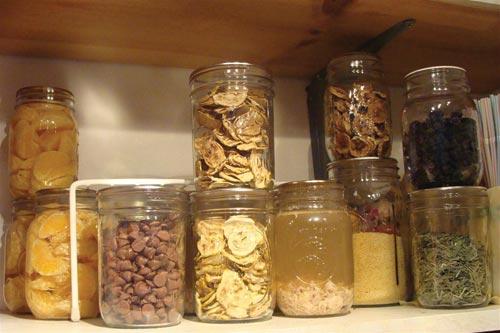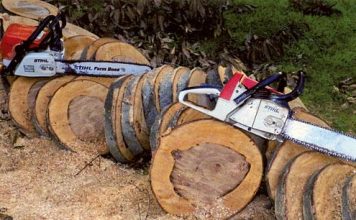 |
|
| Issue #138 • November/December, 2012 |
These days a lot of people are concerned, and rightly so, about their family’s economic stability and security. Recently I’ve become aware of the ways in which I, a stay-at-home mother, can enhance my own family’s feelings of security. I’m going to share my ideas in the hope that they will help others find more peace and comfort in their homes, too.

The place I’ve found that I have the most control, and thus the most leeway, is in the family grocery budget. Many people assume that cutting back on spending here involves either doing without healthy foods or extreme coupon shopping (the kind of couponing where you make a giant project out of trying to get everything free or at almost no cost). Neither assumption is true as long as you know how to gear up and how to strategically use your opportunities.
First I’ll talk about how to “get ready to get ready.” By that I mean little things you can do and in some cases, buy to take advantage of opportunities to be prepared. The biggest revelation I’ve had recently is that being set up is the key; once you are ready to be ready, you can prepare with ease and without a whirlwind of back-breaking work.
Prepping to prep
Start with little, routine things. Here are some you can do right now that will make the rest of this series more useful to you:
1. Every time you prepare veggies for a meal, prep double. This means, for example, if you’re cutting up one onion, cut two while you’re at it and put the second in the freezer for future use. I keep labeled zip top bags in the freezer just for this purpose a bag of chopped onions, a bag of sliced carrots, etc.
2. Every time you prepare a meal, keep all the veggie trimmings everything the onion skins and the celery tops and the carrot shavings and so forth. Put them in another labeled bag in the freezer and add to that bag as you go. Oh, and save the net onion bags. Cut off any metal ends, fold the bags and put them in with the veggies. You’ll use these, I promise! If you have starchy items such as potato peels, put them in a separate bag. Apple and pear peels go in a bag together, citrus peels go together. Banana peels go on the compost pile.
3. When you find something on sale (meat or veggies, fresh or frozen), go for it. Don’t be shy. Get as much as you can afford or have room to store. You don’t have to know what to do with it right away, but when you’ve taken the steps I’ll outline, you’ll have plenty of ideas.
Ok, that’s the small stuff you can do. Now to the stuff I recommend you have but you don’t have to buy new. Ask family and friends if they have any of these. Maybe they would be willing to share their gear and even work together on some of the steps I’ll show you next. Also check your local Craigslist and Freecycle groups. Lots of people are downsizing and you might find just what you’re looking for there.
The items that I strongly urge you to have available are:
1. A food dehydrator. You can dehydrate food in your oven but that ties it up and also costs a lot of money to run. Plus, do you really want to run your oven for hours a day in August? A dehydrator can be set up and left while you do other things like plan the exotic vacation you’ll take when you retire. In the next section of this article I’ll talk a little more about how I use my dehydrators.
2. A pressure canner. Get the largest one that will fit on the largest burner of your stove. This is the only canner you need. You cannot use a pressure cooker for canning unless it is rated specifically for this purpose by the manufacturer, but you can use a pressure canner for canning, cooking, and water bath processing.
3. A vacuum sealer. With this item you’ll also need a few accessories to take full advantage of its usefulness some jar sealers, at least, and a canister sealer if you have a bonus burning money in your pocket. (We’ll talk much more about this in the next article.)
Other items you can pick up as you need them are: canning jars with new lids, a roll of vacuum sealer bags, and canning tools.
Those are the basics. You can certainly invest in more convenience-enhancing items such as a food processor, a stand mixer, a mandolin … whatever. But for now, make sure you have the above items ready to go. I’ll explain how and why to use each of these items and I’ll give you examples of how to get the most out of them.
Now, on to dehydrating!

I stash all my veggie trimmings for making stock in the freezer door where I can get to it daily.
Food dehydrating
As we continue to explore ways to get the most from your family’s food budget without compromising your health or sanity, a food dehydrator is your friend.
First: why would you choose dehydrating instead of freezing or canning?
Dehydrated foods take a small fraction of the storage space that canned or frozen foods do, and with proper storage some can last for up to 30 years. They weigh a lot less, too, so they are very convenient for carrying in a backpack while camping or hiking, and they can go into your emergency storage as well. They are the first choice of disaster and survival experts, which ranks dehydrated foods very high on my list of needs.
There are plenty of websites and books that describe in detail how to operate dehydrators and how to prepare your foods for dehydrating, so I’m not going to go into that here (see web addresses in the sidebar). Instead I’m going to outline scenarios in which your dehydrator is as useful and productive as possible.
Scenario #1: Your cup, and your garden and the farmer’s market, runneth over.
That’s where most of us are every late summer or early fall. Beautiful, fresh produce is available everywhere you look, either free from your own garden, very cheap from the farmer’s market, or via roadside stands. If you have neighbors like my sister Lala, a plethora of squash, tomatoes, and peppers might be left anonymously in a bag on your front porch (repeatedly) overnight while you sleep.
The problem here is that dehydrating can be slow (depending on the weather and so forth), and stuff goes bad quicker at that time of year. And that’s aside from the amount of space you need to store all this extra food. So what I advise here is to prep as much as your dehydrators will hold (you are going to need want covet more than one eventually) and load them up. Then go ahead and prep the rest of your bounty and put it in the freezer. You can pull it out in a couple of days or even weeks from now and put it into the dehydrator then.
In fact, when your local mega-grocery-store has a mega-super-sale on frozen veggies, load up. Those veggies are already prepped for you. Just dump them onto your dehydrator trays and off they go! Warning: this is the gateway drug of food drying; the only way to dehydrate food more passively is to have someone else do it for you.
Scenario #2: Your eyes are bigger, and less discriminating, than your stomach.
This is when you go to the market hungry and you plan to shop for the week, but because you didn’t eat lunch beforehand you end up with 15 pounds of zucchini, one box of strawberries, and a humongous watermelon … not that I’d know anything about such a scenario.
Anyhoo, the idea here is that you eat what you can while it’s fresh and you put the rest in the dehydrator before it goes bad. Thus, you’ll end up with a little of this, a little of that, but as long as you don’t have anything with a strong aroma, it can all go in together and you just take things out as they reach their appropriate stage of doneness.
Things to remember in this scenario: Anything with a heavy aroma or that emits a strong essential oil should be dried separately from other foods and ideally separate from your living area. For example, onions and garlic will permeate every square inch of your house; they will knock down your closet doors and camp in your clothes, and they will drive your friends and family away. Hot peppers will make you wish you had just moved out of your house. I strongly advise you to dry these things in a detached garage or outside.
Anything drippy should be placed on the bottom trays first. Then later, when they have dried a bit, you can rotate them as needed. Fruits dry well with other fruits, veggies with other veggies, and some things can co-mingle just fine.
Scenario #3: Extreme dehydrating: veggie powders.
Ok, you’ve mastered the basics but you want to take it up a notch. You’ve gone out and picked up a few fruit roll-up trays for your dehydrator and have made yourself some handy snacks to take to the park. Now here’s how to put those trays into overdrive.
Puree any leftover veggies from roasts or stews and put them on the trays in the dehydrator. Dry until the mixture crumbles, then put it into your blender or food processor and turn it into a powder. This powder will store indefinitely in an airtight container and you can use it to enrich soups, vegetable smoothies, or what have you. No waste.
If you have a juicer you can do something similar with all the veggie gunk left over from pressing the juice. Make up some packets to carry in your lunch bag, to pack for camping, or to send to your favorite college student in a care package. Just add water and you have a nutritious, delicious meal that is full of vitamins and has in it only the ingredients you choose. And no waste.
How else can you use these powders? Try adding them to your favorite homemade pasta recipe. Use some in your bread or pizza dough. Mix some into the breading for your fried chicken.
Moms-to-be, when you’re in that nesting phase that makes you want to polish all the light bulbs and rearrange the decorative logs in the fireplace, channel that energy into making foods for your baby. Every time you handle something that would make a good starter food ripe bananas, baked sweet potatoes, etc. mash or puree some, dry it and powder it as described above. When it’s time to begin feeding your baby solid foods, you’ll have a nice stash to get you started. You can carry packets in a diaper bag and have a nutritious meal ready with just a little warm water. Plus no waste.
Gardeners: you know how hard it is to get anything to compost in the winter? Dehydrate your stuff, then sprinkle it on the compost pile. Heck, now that I think about it, you can probably just sprinkle the powder directly into the garden.
Lazy gift-giver bonus scenario.
Your dehydrator can be making presents while you sit on the couch with some bon-bons and trashy magazines. Just toss some herbs in the dehydrator, add some flowers and the peels from the apples you used to make a pie and voila! you have the makings of a beautiful potpourri or herbal tea mix. You can also go the old-school route and package some basil, thyme, or rosemary to give to your favorite gourmet cook. Just think of the possibilities. Herbal bath soaks. Dried wreaths. Mulled cider spices. Stuff to simmer on the stove to make visitors think you’ve been baking all day.

Beautiful, fresh produce is everywhere you look, either free from your own garden, very cheap from the farmer’s market or roadside stands, or left anonymously in a bag on your front porch; this is where your dehydrator comes in.
Home canning
When I was growing up, I never saw anybody doing home canning. I know that people did can at home because I saw the canned goods in their homes, and people would often give our family canned food gifts at Christmas. But somehow the actual canning never happened in my presence, and thus I grew up thinking it was some magical and complicated process that was beyond my mere mortal capabilities.
Then I became a stay-at-home mom and had time to investigate. Wow, somebody had been holding out on me.
Home canning is very easy. There are even more books and websites on home canning than there are on food dehydrating, so instead of covering the basics and typing recipes, I’m going to focus on helping you use your “mad canning skilz” to stretch your food budget and make life easier at the same time.
How do you decide whether to can your food or to dehydrate it? I choose dehydrating when I want to put up large volumes of individual ingredients without committing large volumes of storage space. I also dehydrate foods when I don’t have the time to stand over them for processing. I choose canning when I want to put up convenience foods and prepared meal items. This allows me to stock the pantry with easy meals that are ready to go; I just have to open a jar and heat the food to meal temperatures.
Most people start with boiling water bath canning, which is basically putting jars of food in boiling water and keeping them there until the germs are killed and a vacuum has formed. This is a perfect means of preserving most fruits, including whole fruit, fruit slices or pieces, jams, jellies, etc. For this kind of canning you don’t need any special equipment, just a couple of big pots and a way to elevate the jars.
But if you want to put up low-acid foods like veggies or meat, you must turn to pressure canning. That’s not the same as pressure cooking; don’t try to cut corners here by not using the right equipment. When putting food on your pantry shelf you need to be unshakably certain that when you open it months from now it will be safe to eat. Your life literally depends on this.
Follow all instructions in your manual for preparing your pressure canner for use. Follow the USDA guidelines for safe processing pressures and times.
Here are three scenarios for making home canning really work for you.

Dehydrated foods have the advantage of taking up very little space in the pantry.
Scenario #1: Chicken Big.
When you find chicken on sale for a song, buy two, or enough chicken pieces to equal two. Cook them for dinner as you desire bake, roast, boil/poach, grill, etc. You can even use pre-cooked rotisserie chickens from the grocery (I have). Enjoy dinner.
After dinner, set out the slow cooker and some storage containers. Pull the cooked meat off the bones of one of the birds, putting the bones and skin directly into the slow cooker. Divide the meat into portions for making chicken salad, chicken casserole, etc. The number and size of portions you make will depend on the size of the birds and the number of people you need to feed.
From the second bird I cut off a few pieces to put in my husband Rudi’s lunch. I pull the meat off this bird as well, but I set this carcass aside for future use.
Now, remember that bag of veggie trimmings in the freezer? Take out a big handful or two and put them in one of the net onion bags you saved. Tie the ends closed with string or rubber bands and put the bag in the slow cooker with the bones and skin. Add a couple of bay leaves and a few whole peppercorns, cover with as much water as you can, then turn the slow cooker on and leave it overnight.
Meanwhile, put the second carcass and some of the meat portions in the freezer (if you cut off whole pieces, put them in the freezer too). Put other portions in the fridge.
Have a good night’s sleep.
In the morning while waiting for your coffee to brew, strain your broth from the slow cooker into a big container and put it in the fridge to cool.Put the cooked-down veggies in the blender and puree, then put them on a tray in the dehydrator and make a veggie powder for future meals. Wrap the bones well for the trash so no animals get into them and choke (or pressure cook until the bones are soft enough to be mashed, dehydrate, and voila bone meal for the garden).
That evening, set up your pressure canner and get your jars and lids ready. While the canner is heating up, skim the fat from your chicken broth.
Put the stock and some of the meat from the fridge, chopped, on the stove and heat them to boiling. The whole thing needs to boil for about five minutes to make sure each piece of meat is thoroughly hot to its center. Ladle the stock with some meat into your cans, put the lids on, put them in the canner, then process according to the instructions for your canner and the USDA recommendations for canning in your area.
Afterward, once everything is cool and you’ve confirmed you have a good seal on the jars, wipe them clean and put them in the pantry. When it’s time to make soup, just add a handful of veggies from your dehydrated stash, heat everything up until the veggies are plump and hot, and ladle the mixture over cooked rice or noodles.
Repeat the whole process with the second carcass when you have time or energy. As long as it is in the freezer, it will keep until you are ready, and you don’t even have to thaw it first.
The total amount of food you will have when done with this process will depend on the size of your birds, and to some extent on the size of the crock pot you use, but my totals most recently were: 12 pint jars of chicken soup (if you don’t want or need 12 jars of soup you can always just put up plain stock), eight servings of chicken casserole, four servings of chicken salad (I probably could have made this go further if I’d cut the meat pieces smaller), two pieces of thigh and two legs to send with Rudi for lunch at work, and eight cups of shredded meat in the freezer for future use enough for two more casseroles, a couple more chicken salads, and for adding to something like fried rice or green salads.
It sounds like a lot of work, but most of it is passive. The slow cooker runs while you’re sleeping; you just set a timer and check on it periodically, like putting something in the oven.
Two tips: Aromatics, herbs, and spices become more potent in storage, so go lightly. You can always add more, but you can’t take it away once it’s in.
Starches inhibit the canning process tremendously, so if you wish to serve your soups with rice or pasta, or you wish to thicken your stock or soup, do that when you open the cans for making your meal.

If you’re already chopping vegetables and filling jars, chopping and filling a few more only takes a little more time because you’re already set up for it. But small batch preserving might be right up your alley and having a few jars of this and that is a great way to start building up a good pantry.
Scenario #2: There’s the beef.
Now here’s the way to get the most and I’m not kidding from a ground beef windfall. Let’s assume you’ve gotten a great deal and purchased 10 pounds of hamburger.
Usually, the first step in any ground beef recipe is “brown the meat.” Do you know how long it takes to brown that much ground meat? So we’re going to cut some corners. I guarantee you won’t notice the difference.
Start with your 10 pounds of ground meat (which can be a mix of meats if you prefer). Put it all in a big stock pot, cover with as much water as you can reasonably put in the pot, plus a net onion bag full of veggie trimmings and a few herbs. Then boil. You heard me. Boil. Stir it from time to time and break up the meat as you do. Boil it as long as you can stand it. Eventually you’ll look at it and think, “hmmm, that looks done.” At that point, take it off the stove and let it cool down a bit, then put it in the fridge to cool completely.
I recommend boiling the meat instead of browning because it not only saves time, but you will end up with broth. You don’t get broth when you brown meat, at least not without adding another time-consuming step. Since you’re going to season this meat later, it doesn’t matter that you boiled it. The seasoning gives it the characteristic flavor of the dish in question, and you have converted both the broth and the meat to very low-fat foods.
If you do this process late in the afternoon you can take some of the meat for dinner tacos, sloppy joes use your imagination. After that, put the pot of cooked meat in the fridge overnight. Now you get to sleep through the whole cooling process.
When it’s cool, skim the fat off the top of the broth. Strain out the ground meat and set it aside (covered and in the fridge is good). Reheat the broth to boiling, ladle it into jars, and process it in your pressure canner according to the manual and the USDA instructions for processing meat broth.
While the jars are in the canner you can start working on the meat. Divide the cooked ground meat into portions that are the right size for your family’s needs. Season each portion according to the kinds of meals you want to serve. I do some with taco seasoning, some with sloppy joe seasoning, and I leave some unseasoned to use in spaghetti sauce or shepherd’s pie.
When the broth comes out of the canner you can process your jars of meat. They can all go in the canner together because they all have the same processing time. Again, follow all instructions for safe ground beef processing.
When everything is cooled and you’ve confirmed that the seals are good, you are ready to tuck your precious jars into the pantry.
Your finished amounts will depend on the size of the portions you created and the amount of water you used to make your broth. For my family, this process yields: eight pints of broth, two dozen tacos, six sloppy joe sandwiches, six spaghetti servings, and two big pots of chili (more than two dozen servings).
The meat you left unseasoned can be used for so much more than just spaghetti sauce. Pull it out when you want to make quick stuffed peppers or cabbage rolls. Make your own Hamburger Helper meals or a Tex-Mex salad. Ground meat is pretty flexible and having it already cooked makes dinner a breeze.
The seasoned beef is plenty versatile too. Use your taco meat mix for nachos or burritos or empanadas. Use spaghetti sauce for lasagna. Use sloppy joe mix for dressing up baked potatoes or in lettuce wraps.
Tip: Remember the beef fat you skimmed off? You can use a little of that when you heat up the meat prior to seasoning; it adds back that little bit of browning that some people miss.
You can do this same scenario with non-ground meat you simply adjust the processing time according to what you’re canning, and of course season the meats according to the meals you think you would like to make.

I grew up thinking canning was some magical and complicated process that was beyond my mere mortal capabilities.
Scenario #3: Veggie madness.
We’ve all been there. Your garden went haywire and you have enough squash to feed the neighborhood. Or you found a roadside stand selling rhubarb for pennies.
To get the maximum food security benefit, just follow the directions for the kind of vegetable you want to can, and you’re done but really crank it up.
After every meal, put whatever leftover veggies you have into an appropriate canning jar and stash it in the freezer. When you’ve amassed enough jars to make one canner-load, take them all out and let them come to room temperature. (This is important! You don’t want jars exploding inside your canner; that is not good eats.) Add enough boiling water to each jar to cover the vegetables.
Heat each jar until the contents boil. The time this takes will depend on what’s in the jar. I use the microwave for this, but you can certainly dump each jar into a pot if you prefer.
Then set up your canner and process your foods. Use the time and pressure that is appropriate for the item that takes longest to process.
By doing it this way, you end up with a wide variety of prepared foods, ready to eat off the shelf, without the trouble of processing huge batches of any one thing at a time.
You can also can foods that you’ve fermented or brined, such as sauerkraut or pickles of all sorts. Again, process according to the instructions in your canner manual and the USDA instructions for processing vegetables.
Tips: Highly-seasoned foods can become very strong after canning, so plan to mix them with a batch of unseasoned items when you serve.
If you wish, you can mix different cooked veggies in the same jar, but you should not mix uncooked with cooked.
You can make your own baby foods by pureeing any appropriate veggies you have on hand and canning them. Use the cute little jelly jars with the quilted pattern on them and they make a fantastic gift for a new mother-to-be!
There you have it: three of the countless ways you can turn your pressure canning operation into a machine that fills your pantry without forcing you to quit your job to get it all done.
Finally, this is probably the most important tip I can offer on the subject of canning foods: use the most up-to-date sources of information and recipes you can find. Do not rely on old family cookbooks or methods handed down from your great-grandmother. Scientific research has determined the safest and most efficient methods for making your canned food safe to eat. I won’t lecture too much on this, but I will remind you that botulism is serious and deadly.
Don’t be afraid. Just follow directions. You can do it!
Online food dehydrating resources
Pick Your Own: This an awesome website for all kinds of food preservation info and advice. Try to look beyond the typefacethere is some good stuff here.
Dehydrate2store: has lots of videos and tons of recipes for using your dehydrated foods.
Drying Foods at Home: This document from the Purdue University Extension Office contains a wealth of information on choosing dehydrators, methods of using them, and ways to treat different foods for best results.
Read Food security 101: part 2 – Convenience mixes make life easier.
Rowena Aldridge is a former professional ballerina who now spends her days homeschooling and homemaking. She is a certified educator in a number of old-school domestic skills, including food preservation (University of Georgia Extension), small space gardening (Square Foot Gardening Foundation), and patternmaking for sewing (Wild Ginger Software, Inc). She is the co-author of Digital Flat Pattern, the only college-level textbook on digital pattern drafting for the fashion industry. But her real passion is empowering others to go out and conquer the world on their own terms.
Learn more about her classes and other projects at www.romesticity.com.















What a wonderful article! Thank you so much for information I didn’t know I didn’t know about. I have everything on your list plus a freeze dryer but have to admit to never having canned anything ever. I got all the equipment for canning years ago but was always afraid to do it in reality. This article just made canning easier in my own mind & I appreciate it. Thank You!